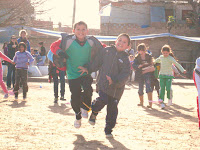
"Bom Dia, Luis!"
Sibrydais yn dawel i ddechrau, rhag rhoi sioc iddo fe, yna'n uwch, gan gyffwrdd ei ysgwydd. Dim byd. Dim ond chwyrnu.
"LUIS!..." Dim.
Roedd ein tywysydd yn cysgu'n sownd ar ei gefn ar fainc yn y gwersyll ar ol dod nol o'r 'Jungle Disco' hanner awr ynghynt. Roedd hi nawr yn 5.30 y bore a'r wawr wedi hen dorri. Ei eiriau olaf cyn ein gadael ar ein pennau'n hunain ynghanol y jwngl dros nos, oedd y byddai'n ein cymeryd mas i weld y wawr yn torri ac i edrych am ddolffins yr Amazon yn y bore. Ond doedd dim symud arno.
Ar ol tynnu'r hen ganiau cwrw mas o'r canw, penderfynon ni fynd mas i chwilio am ddolffins ar ein pennau'n hunain. Roedd y goedwig law yn dihuno, gyda gwenoliaid yn sisyrnu uwch ein pennau, ambell i bili-pala melyn yn fflitian dros y dwr, a'r awyr pinc-las yn adlewyrchu ar afon ddu Urubu oddi tanon ni.
Ymddangosodd y llamhidyddion ddim tan i ni droi'r canw nol am y gwersyll - ond roedd e werth aros i'w gweld nhw'n troelli yn y dwr wrth bysgota am eu brecwast.
Roedd Luis yn llawn ymddiheuriadau pan gyrhaeddon ni nol. Fe ddwedon ni wrtho fe bod dim ots, gan i ni weld y dolffiniaid beth bynnag. Ond yna, mas o'r caban, daeth menyw - ei gariad - a daeth hi gyda ni am weddill ein hymweliad a choedwig law yr Amazon. Ar ol hynny, doedd meddwl Luis ddim fel pe bai'n llwyr ar ei waith...




Ond mae'r goedwig law yn union fel ro'n i wedi'i ddychmygu - coedwig drwchus gwlyb a phoeth o goed tal cryf gyda choron o ddail ar eu pen, coed pigog, coed palmwydd a gwinwydd jyngl yn hongian lawr yn barod i fwnci siglo arnyn nhw... Ond welon ni ddim mwnci.... Fe welon ni ddigonedd o chwilod, trychfilod a morgrug - a dihuno i swn gwichian a chnoiadau mosgitos... Roedd 'cow-flies' fel cwn yn ein dilyn i bobman, ac ar un adeg fe neidiodd sboncyn y gwair mawr hyll a du a glanio ar fy nhrwyn.
Ar ol diwrnod o chwysu'n stecs dan yr haul, ro'n ni'n cysgu bob nos mewn hamocs dan y coed. Yr unig ryddhad o'r gwres oedd dip yn yr afon neu dan raeadr hyfryd o oer. Ac er yr hoffen i ddweud yn wahanol, erbyn y diwedd ro'n i'n ysu am gawod, gwely, glendid a thy bach go-iawn....
Mae 'da fi theori - does dim croeso i wybed, morgrug na thrychfilod yn fy nghartref i - ond rhaid i fi eu parchu nhw yn eu cartref nhw... Nawr, ar ol bod i'w cartref nhw heb wahoddiad, falle'u bod nhw'n trio dweud wrtha i nad oes croeso i fi yno chwaith...




















































